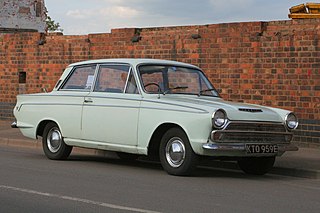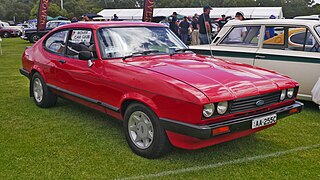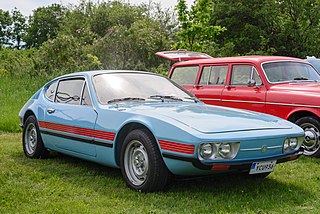
The Ford Cortina is a medium-sized family car manufactured and marketed initially by Ford of Britain, and then Ford of Europe in various body styles from 1962 to 1982, over five generations. It was the United Kingdom's best-selling car of the 1970s.

The Ford Fiesta is a supermini car that was marketed by Ford from 1976 to 2023 over seven generations. Over the years, the Fiesta has mainly been developed and manufactured by Ford's European operations, and had been positioned below the Escort.

Coupé de ville — also known as town car or sedanca de ville — is a car body style produced from 1908 to 1939 with an external or open-topped driver's position and an enclosed compartment for passengers. Although the different terms may have once had specific meanings for certain car manufacturers or countries, the terms are often used interchangeably.

The Ford Capri is a fastback coupé built by Ford of Europe, designed by Philip T. Clark, who was also involved in the design of the Ford Mustang. It used the mechanical components from the Mk2 Ford Cortina and was intended as the European equivalent of the Ford Mustang. The Capri went on to be highly successful for Ford, selling nearly 1.9 million units in its lifetime. A wide variety of engines were used in the car throughout its production lifespan, which included the Essex and Cologne V6 at the top of the range, while the Kent straight-four and Taunus V4 engines were used in lower-specification models. Although the Capri was not officially replaced, the second-generation Probe was effectively its replacement after the later car's introduction to the European market in 1994.

The Ford Del Rey is a midsized car produced by Ford do Brasil in Brazil from 1981 to 1991. It was a successor to the Ford Landau as the flagship model of the lineup and to the higher priced versions of the popular Ford Corcel II. Like the Corcel II, the Del Rey was designed exclusively for Brazil, but was sold in Chile, Venezuela, Uruguay, and Paraguay, as well.

Imperial was the Chrysler Corporation's luxury automobile brand from 1955 until 1975 and again from 1981 through 1983.

The Ford Fairmont is a model line of compact cars that was manufactured by Ford from the 1978 to 1983 model years. The successor of the Ford Maverick, the Fairmont marked the third generation of compact sedans sold by Ford in North America. Initially slotted between the Pinto and Granada within the Ford line, the Fairmont was later marketed between the Ford Escort and Ford LTD. In contrast to its predecessor, the model line was offered as a two-door notchback sedan, two-door coupe, four-door sedan, and five-door station wagon. Though never sold as a Lincoln, Mercury sold a divisional counterpart of the Fairmont as the Mercury Zephyr.

Carrozzeria Ghia SpA is an Italian automobile design and coachbuilding firm, established by Giacinto Ghia and Gariglio as "Carrozzeria Ghia & Gariglio". The headquarters are located at Corso Guglielmo Marconi, 4, Turin. The company is currently owned by Ford Motor Company and focused on the European market through Ford's subsidiary in the region.

The Lincoln Versailles is a mid-size luxury car that was marketed by Lincoln from the 1977 to 1980 model years. The first Lincoln introduced outside of the full-size segment, the Versailles is a rebranded version of the Ford Granada and Mercury Monarch. Replacing the Mercury Grand Monarch Ghia, the model line was introduced as a competitor to the Cadillac Seville.

The Ford Tempo is an automobile that was produced by Ford from the 1984 to 1994 model years. The successor of the Ford Fairmont, the Tempo marked both the downsizing of the Ford compact car line and its adoption of front-wheel drive. Through its production, the model line was offered as a two-door coupe and four-door sedan, with the Mercury Topaz marketed as its divisional counterpart.

The trunk or boot of a car is the vehicle's main storage or cargo compartment, often a hatch at the rear of the vehicle. It can also be called a tailgate.

The Ford Escort is a small family car that was manufactured by Ford of Europe from 1968 until 2000. In total there were six generations, spread across three basic platforms: the original, rear-wheel-drive Mk.1/Mk.2 (1968–1980), the "Erika" front-wheel-drive Mk.3/Mk.4 (1980–1992), and the final CE-14 Mk.5/Mk.6 (1990–2002) version. Its successor, the Ford Focus, was released in 1998, but the final generation of Escort was phased out gradually, with the panel van version ending production in 2002 in favour of the Ford Transit Connect.

The Mercury Marquis is a model line of automobiles marketed by Mercury from 1967 to 1986. Deriving its name from a title of French nobility, the Marquis was introduced as the divisional counterpart of the Ford LTD; four generations of the two model lines were paired through rebranding. Initially slotted as the flagship Mercury full-size range, the Marquis would serve as the basis for the later Mercury Grand Marquis.

The De Tomaso Mangusta is a sports car produced by Italian automobile manufacturer De Tomaso between 1967 and 1971. It was succeeded by the De Tomaso Pantera.

The Volkswagen SP2 is a sports car that was developed by Volkswagen do Brasil and built from July 1972 until December 1975. It is based on the chassis of the Brazilian market Volkswagen Type 3. "SP" is said to be an initialism of São Paulo, where the car was built, or of "sports prototype". In its issue of 20 June 1973, German technology magazine Hobby called the SP2 the "most beautiful Volkswagen in the world".

A continental tire or a continental kit is used in the United States for an upright externally-mounted spare tire behind an automobile's trunk.

The European Ford Granada is an executive car manufactured by Ford Europe from 1972 until 1994.

The North American version of the Ford Granada is a range of sedans that was manufactured and marketed by Ford over two generations (1975–1982). Developed as the original successor for the Ford Maverick, the Granada shares its name with Ford of Europe's flagship sedan. The model line was marketed as a luxury compact vehicle, expanding the segment in the United States.

The Honda Stepwgn is a minivan produced by Honda since 1996. In contrast to the Odyssey and also the Stream, it sports a taller, more upright greenhouse and can accommodate eight people instead of seven. For its first two generations, the car had one door on the driver's side and two doors on the passenger's side.

The Ford Fiesta Mk1 is the first generation of the Ford Fiesta supermini. It was introduced in 1976 as Ford Europe's first multi-national front-wheel-drive automobile, and was available in both 3-door hatchback and panel van derivatives. In 1983, the Fiesta was updated, and the Fiesta Mk2 was introduced.



















